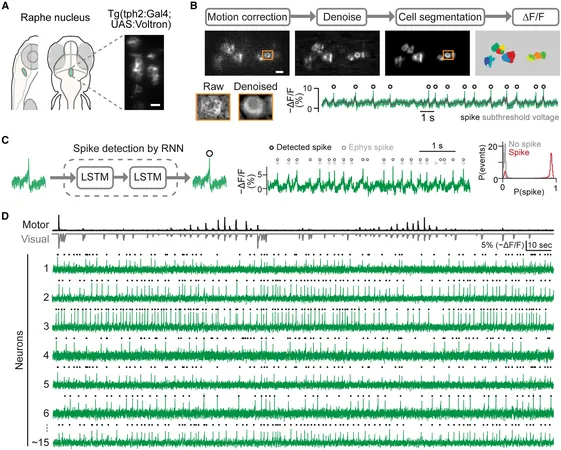
Unlocking the Secrets of the Brain: How Fish in Virtual Reality Are Helping Us Understand Neuromodulation
2025-06-11
Author: Li
Revolutionary Research on Brain Functionality
Researchers at Janelia are delving deep into the intricate ways in which neurons perform calculations tailored to an animal's movements and surroundings. Their focus? The precise release of neuromodulators—powerful chemicals that refine brain activity and help us adapt to changing situations.
Potential Breakthroughs for Mood Disorders
These groundbreaking findings could pave the way for a clearer understanding of how the brain fosters flexible behavior. This knowledge could ultimately illuminate the complexities of mood disorders, particularly depression.
The Role of Neuromodulators vs. Neurotransmitters
Unlike neurotransmitters that facilitate speedy communication between neurons, neuromodulators operate over slower timeframes, regulating groups of neurons collectively. These vital chemicals modulate our brain's responses, influencing our behavior, mood, and thought processes.
Zebrafish: Nature's Neuromodulation Laboratory
In an exciting twist, researchers turned to larval zebrafish, where the neuromodulator serotonin plays a critical role in controlling the intensity of their swimming based on environmental changes or personal physical states. Previous studies from the Ahrens Lab revealed that serotonergic neurons in the dorsal raphe nucleus utilize visual cues to gauge swimming effectiveness and adjust effort levels by releasing serotonin.
Decoding Neuromodulation Mechanisms
In new research featured in the journal Neuron, the Ahrens Lab team explored how these neurons determine when and how much serotonin to release. While past studies have concentrated on the effects of neuromodulators on neuronal circuits, less attention has been given to how the neuromodulatory system processes information itself.
Virtual Reality: A New Frontier in Research
Using a virtual reality setup, the researchers meticulously monitored activity in the raphe with advanced voltage sensors and neurotransmitter imaging tools. They discovered that zebrafish employ a stop-and-go swimming pattern, and the serotonergic neurons in the raphe only absorb information about perceived motion immediately after swimming.
The Fascinating 'Gating' Process
The team identified an intriguing 'gate' mechanism: this gate closes when the fish is still and opens right after a swimming session begins. This allows the raphe's cells to integrate relevant visual cues, enabling more tailored responses while filtering out extraneous visual information.
Surprising Findings on Neuronal Activity
Further investigation revealed that swimming initially dampens activity in the serotonergic neurons. Upon stopping, however, these neurons experience a surge in activity—a rebound effect akin to the spring of a compressed balloon. During this phase, the gate opens, allowing visual signals to energize the neurons, thus enhancing serotonin release and adjusting swimming vigor even further.
Implications for Neuroscience and Beyond
This fresh insight into the neuromodulatory system presents profound implications not just for neuroscience but also for fields like machine learning, where understanding how systems learn from experience is crucial. This research could reshape our approach to brain functionality and its complex dynamics.

 Brasil (PT)
Brasil (PT)
 Canada (EN)
Canada (EN)
 Chile (ES)
Chile (ES)
 Česko (CS)
Česko (CS)
 대한민국 (KO)
대한민국 (KO)
 España (ES)
España (ES)
 France (FR)
France (FR)
 Hong Kong (EN)
Hong Kong (EN)
 Italia (IT)
Italia (IT)
 日本 (JA)
日本 (JA)
 Magyarország (HU)
Magyarország (HU)
 Norge (NO)
Norge (NO)
 Polska (PL)
Polska (PL)
 Schweiz (DE)
Schweiz (DE)
 Singapore (EN)
Singapore (EN)
 Sverige (SV)
Sverige (SV)
 Suomi (FI)
Suomi (FI)
 Türkiye (TR)
Türkiye (TR)
 الإمارات العربية المتحدة (AR)
الإمارات العربية المتحدة (AR)